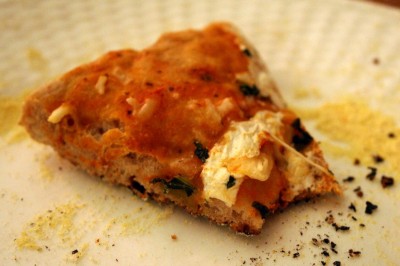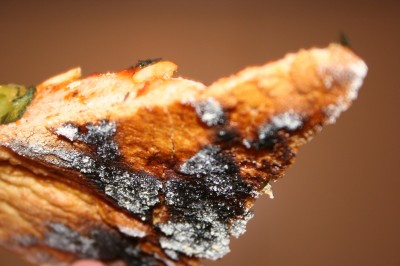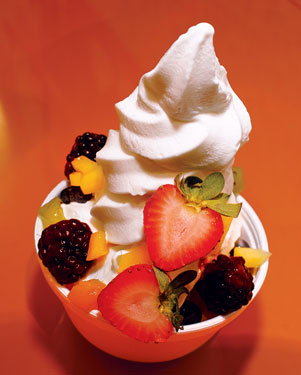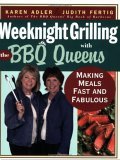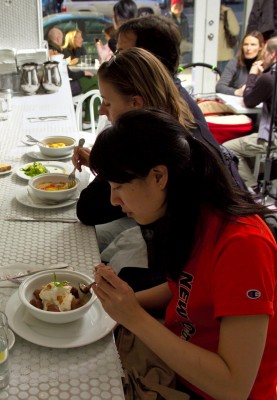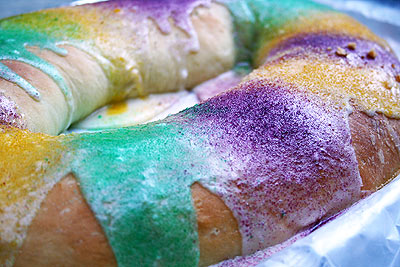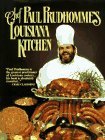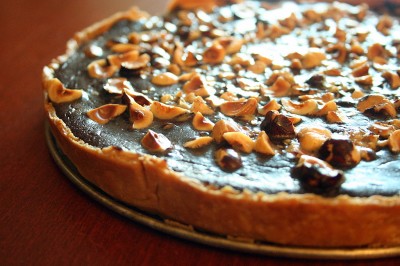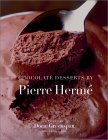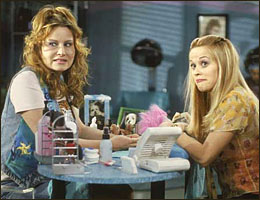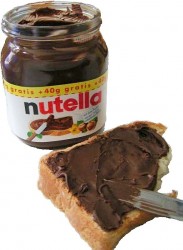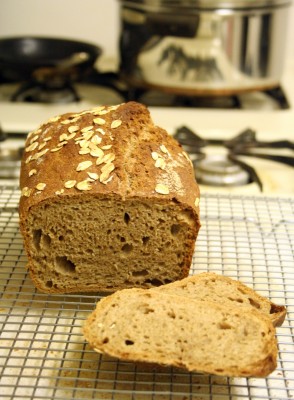
The last time I checked, more than 200 bloggers made Sullivan Street Bakery’s no-knead bread, one of the easiest things in the world. You mix flour, salt, yeast and water in a bowl and leave it out for about 18 hours. Then you shape the dough (which is as simple as folding an envelope) and let it rise for a couple hours more. After baking, you get a crusty, spongy bread that sops up olive oil like no other. The secret, as the New York Times article said, is letting time do the work.
Although a follow-up article said you can replace up to half the white flour with whole wheat flour, I’ve never seen specific instructions for how to make a 100% whole wheat loaf. In my opinion, it’s not whole wheat bread unless 100% of the flour is whole wheat. Otherwise, you get a paltry gram of extra fiber in each slice, which isn’t even worth it.
Whole wheat bread often sneaks in white flour because whole wheat is more difficult to work with. The bran is coarse and cuts through air pockets before they finish forming. Adding vital wheat gluten (protein) makes the dough “stronger” so it can rise. Also, whole wheat flour soaks up more liquid. The dough must be very soft, like a stiff muffin batter, so the yeast can move around to do its work. I’ve heard that whole wheat bread should have 100% hydration (a 1:1 ratio of flour and water by weight).
Armed with this knowledge, I added about an extra half cup of water and 1 1/2 Tbsp of vital wheat gluten. It works, it really works!
It is not as airy as the original recipe, but it passes as everyday sandwich bread. You can add more gluten (use up to 1 Tbsp for every cup of flour), but I don’t like the taste. It reminds me of a bad protein bar.
A couple notes: you do not need special instant yeast for the recipe. I read that NYC grocery stores ran out of instant yeast because people were baking like mad. To substitute regular active dry yeast, use 25% more and dissolve it in a little of the reserved water. Instant yeast is finer and more viable, which is why you can add it directly to flour and use less of it.
I had the greatest success with King Arthur’s hard red spring wheat flour. I usually buy what’s cheapest, but other brands like Whole Foods, Gold Medal and Hecker’s are more coarse. Remember, more coarse = less rise. Flour is so cheap anyway that you can afford to spend a couple more bucks on a good brand. It could make the difference between beautiful bread and a grassy tasting doorstop. On the downside, King Arthur isn’t as nutty-tasting as other brands, but it also isn’t sour and grassy (like Whole Foods).
Because the dough is so sticky, you need about an extra half cup of flour to dust your hands and shaping surface.
Also, because the whole wheat dough is wetter, you need about an extra 10 minutes in the oven.
If you don’t have a heavy oven-ready pot or don’t want such a flat loaf, you can use a standard loaf pan. Cover the top with an upside-down casserole dish or a tent of foil so it doesn’t brown too quickly. A trick to getting nice crust is to preheat a pan (not glass-it will shatter) on the oven floor and fill it with hot water during baking. I think it’s worth the extra step. Of course, if you have a covered pot, it will create its own steam. Why does steam create crisp crusts? I don’t know, but here’s an explanation on Peter Reinhart’s blog. I tried to get the best of both worlds (loaf shape and a hot covered pot) by putting a loaf pan inside a casserole dish and filling the gaps with water. The lid kept clanking as the water violently boiled. But it created an amazing brown top and permeated my apartment with the scent of caramelized bread for a day. However, the sides and bottom of my loaf didn’t brown because it was insulated by the extra glass. I also tried putting the whole apparatus on the bottom rack and turning the oven up to 500 F. The browning was better, but the crust set before the loaf had a chance to finish expanding.
No-Knead 100% Whole Wheat Bread
Adapted from the New York Times and Jim Lahey of Sullivan Street Bakery
Time: About 1 1/2 hours plus 14 to 20 hours rising
(The metric measurements are more accurate.)
3 cups (430 grams) whole wheat flour, plus 1/4-1/2 cup more for dusting
1/4 teaspoon (1 gram) instant yeast (or 1/4 plus 1/16 teaspoon active dry yeast*)
1 1/4 teaspoons (8 grams) salt
1 1/2 tablespoons vital wheat gluten
2 cups minus 1 tablespoon (430 grams) water
Cornmeal or wheat bran as needed
1. In a large bowl combine flour, instant yeast, salt and vital wheat gluten. Add 1 1/2 cups water and stir until blended. Keep adding water until the dough is shaggy and sticky, like a stiff muffin batter. It should not be so wet that it’s pourable. You will probably use all of the water, but different brands of flour are more absorbent. Cover bowl with plastic wrap. Let dough rest at least 12 hours, preferably 18, at warm room temperature, about 70 degrees.
2. Dough is ready when its surface is dotted with bubbles. Liberally flour a work surface and place dough on it; sprinkle it with more flour and fold it over on itself once or twice. Cover loosely with plastic wrap and let rest about 15 minutes.
3. Using just enough flour to keep dough from sticking to work surface or to your fingers, gently and quickly shape dough into a ball. Generously coat a cotton towel (not terry cloth) with flour, wheat bran or cornmeal; put dough seam side down on towel and dust with more flour, bran or cornmeal. Cover with another cotton towel and let rise for about 2 hours. When it is ready, dough will be more than double in size and will not readily spring back when poked with a finger.
4. At least a half-hour before dough is ready, heat oven to 450 degrees. Put a 6- to 8-quart heavy covered pot (cast iron, enamel, Pyrex or ceramic) in oven as it heats. When dough is ready, carefully remove pot from oven. Slide your hand under towel and turn dough over into pot, seam side up; it may look like a mess, but that is O.K. Shake pan once or twice if dough is unevenly distributed; it will straighten out as it bakes. Cover with lid and bake 30 minutes, then remove lid and bake another 15 to 30 minutes, until loaf is beautifully browned. Cool on a rack.
Yield: One 1½-pound loaf.
*If substituting active dry yeast, let it proof in 1/4 cup of lukewarm water (reserved from the total water) for 10 minutes. Add the yeast with the rest of the water when mixing it in the dough.
Links: Video of Martha Stewart jumping on the bandwagon and making the bread.

stresses lots of produce and good quality, portion-controlled desserts). Salads just taste better in Paris, and I had the best cake of my life at Pierre Herme. But the French aren’t into whole wheat bread. The first meal I ate after my week-long trip last year was a PB&J sandwich on whole wheat bread and a glass of soy milk. Heaven.




